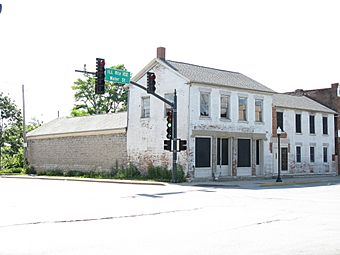Eagle Hotel (Wilmington, Illinois) facts for kids
Quick facts for kids |
|
|
Eagle Hotel
|
|
 |
|
| Location | 100 N. Water St., Wilmington, Will County, Illinois, U.S. |
|---|---|
| Built | c. 1837 |
| Architectural style | Mid 19th Century Revival |
| NRHP reference No. | 94000021 |
| Added to NRHP | February 16, 1994 |
The Eagle Hotel is a very old building in Wilmington, Illinois. It used to be a busy hotel. Today, it is known for its long history in the town.
Contents
A Look Back at the Eagle Hotel
Early Days in Wilmington
The first people settled in Wilmington in 1836. They liked the area because it had many streams and lots of wood. A man named Thomas Cox planned out the town. He also built the first grist mill, which was a place to grind corn and wheat.
Farmers came from far away to use the mill. They needed a place to stay while their grains were being ground. David Lizer bought the land where the hotel stands in 1836. He probably started the hotel project himself. The exact year the hotel was built isn't known. It was likely built after the town's first general store in 1837. The building might have first stored goods for the mills. It may have also been a trading post.
Building the Hotel
Henry Brown owned the town's general store. He built the two-story Eagle Hotel across the street from his store. The hotel was on Water Street. It didn't have one specific style. However, it looked a lot like buildings from the Greek Revival movement.
In the 1840s, a new part was added to the hotel. This new section connected the hotel to a warehouse. It also had a storefront. Other businesses could rent this space to sell their goods.
Busy Times and Changes
The hotel business grew when Wilmington got a train connection. The Chicago and Alton Railroad arrived in the early 1850s. More people came to town, which was good for hotels.
However, another fancy hotel, the Exchange Hotel, opened in 1844. It was built right across the street. The Eagle Hotel didn't get as much new business as the Exchange. To stay open, the Eagle Hotel offered cheap rooms. Many families new to the area stayed there.
Later, U.S. Route 66 was completed. This famous road brought even more travelers. Still, the Eagle Hotel had to change. It became a boarding house, offering longer stays. In the 1940s, the building was turned into apartments. Small shops continued to use the storefront until 1982.
Saving a Piece of History
The Wilmington Area Historical Society bought the building in 1982. They turned it into a museum. Sadly, a fire badly damaged the old hotel in 1990. But people worked hard to fix it.
In 1994, the Eagle Hotel was added to the National Register of Historic Places. This means it is an important historical site. In 2023, Mark Nielsen owned the Eagle Hotel. It remains a key part of Wilmington's past.



